
Revolutionary Spider Fang Morphology Study: The Key to Cutting-Edge Tools!
2024-09-25
Author: Olivia
Introduction
When we envision spiders, images of their intricate webs often take center stage. However, few are aware of their remarkable ability to cut through extremely tough materials, including their own silk—the strongest natural fiber—and synthetic options like carbon or Kevlar.
A groundbreaking research initiative led by the University of Trento has unveiled the mechanics behind this extraordinary capability, with findings published in the prestigious journal Advanced Science.
The Mystery of Spiders' Cutting Prowess
For years, scientists speculated that the answer to spiders' cutting prowess lay in their chemistry, specifically their ability to produce digestive enzymes that can degrade silk fibers. Yet, this alone could not account for their speed and precision during high-stakes moments.
"We aimed to uncover how spiders interact with materials that aren't their own," stated Nicola Pugno, a professor at UniTrento and a key author of the study. Joining him was Gabriele Greco, a researcher from the Swedish University of Agricultural Sciences, who emphasized the importance of understanding both natural and synthetic fibers.
Investigating Cutting Mechanisms
The research team constructed webs using synthetic materials, such as threads made of carbon and Kevlar, to further investigate spiders' cutting mechanisms. Their observations revealed that while chemical properties played a role, the true secret to their cutting accuracy was found in the unique design of their fangs.
Discoveries Under the Microscope
Under the scrutiny of a scanning electron microscope, researchers discovered a fascinating feature of spider fangs: a functionally graded system of serrations. The serrations are strategically spaced, increasing from the tip of the fang, which facilitates optimal cutting conditions. As a fiber is drawn inward, it becomes trapped along a serrated edge that is ideally sized for maximum engagement. This ingenious geometry significantly reduces the force needed to execute a cut and enhances efficiency.
Implications and Future Prospects
The implications of these findings are exciting, offering insights that could extend beyond the realm of spiders. "This novel theory could inspire tools that are not only sharper but also more efficient," Pugno claims. "Imagine tools designed to make cutting wood, metal, stone, food, or even hair easier and more precise—all thanks to inspired designs based on spider fangs."
As scientists continue to unravel the complexities behind such natural mechanisms, we may soon see a new wave of cutting tools that revolutionize industries across the board. Who knows? We might be on the verge of a cutting revolution spearheaded by our eight-legged friends!









 Brasil (PT)
Brasil (PT)
 Canada (EN)
Canada (EN)
 Chile (ES)
Chile (ES)
 España (ES)
España (ES)
 France (FR)
France (FR)
 Hong Kong (EN)
Hong Kong (EN)
 Italia (IT)
Italia (IT)
 日本 (JA)
日本 (JA)
 Magyarország (HU)
Magyarország (HU)
 Norge (NO)
Norge (NO)
 Polska (PL)
Polska (PL)
 Schweiz (DE)
Schweiz (DE)
 Singapore (EN)
Singapore (EN)
 Sverige (SV)
Sverige (SV)
 Suomi (FI)
Suomi (FI)
 Türkiye (TR)
Türkiye (TR)